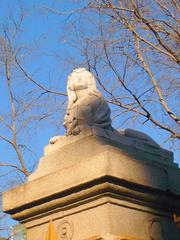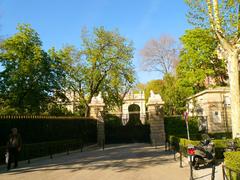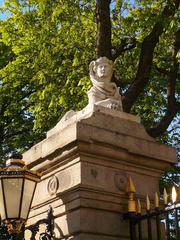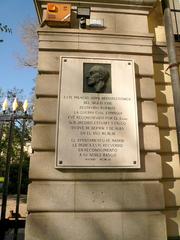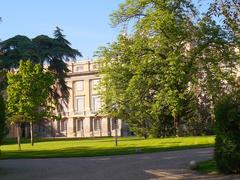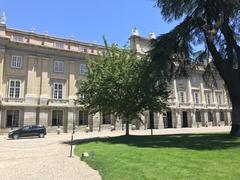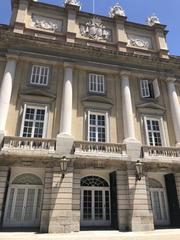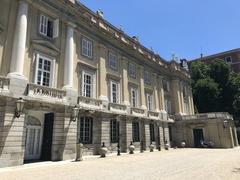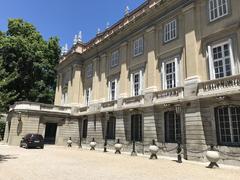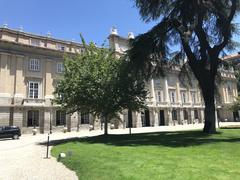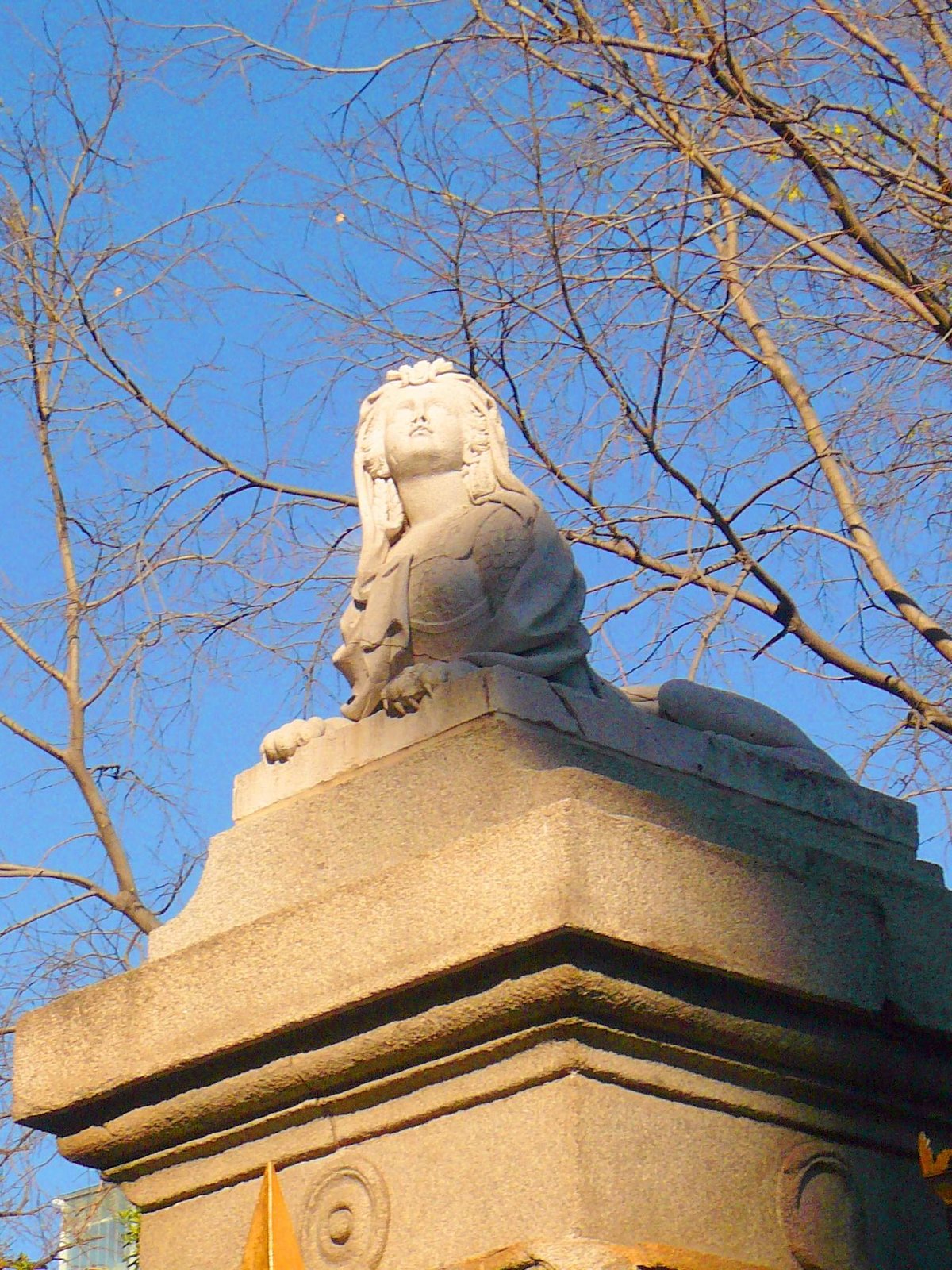
Liria Palace Madrid: Visiting Hours, Tickets, and Historical Significance
Date: 14/06/2025
Introduction
Liria Palace (Palacio de Liria) is one of Madrid’s most distinguished historical landmarks—an exquisite blend of neoclassical architecture, world-renowned art collections, and the living legacy of the House of Alba, one of Spain’s most illustrious noble families. Built in the late 18th century, the palace has evolved from a private aristocratic residence to a vibrant cultural venue, now open to the public. This comprehensive guide covers the palace’s history, architecture, collections, contemporary exhibitions, essential visitor information—including Liria Palace visiting hours, ticketing details, accessibility, and nearby attractions—ensuring you make the most of your visit to this Madrid historical site (Headout; Fascinating Spain; Spain.info).
Table of Contents
- The History and Evolution of Liria Palace
- The House of Alba: Dynastic Heritage
- Architectural Highlights and Restoration
- The Art Collection: Masterpieces and Manuscripts
- Liria Palace Today: Living Heritage and Public Access
- Contemporary Art at Liria Palace: Joana Vasconcelos’ “Flamboyant” Exhibition
- Visitor Information: Tickets, Hours, Accessibility, and Travel Tips
- Nearby Attractions
- Frequently Asked Questions (FAQ)
- Summary and Travel Recommendations
- References
The History and Evolution of Liria Palace
Origins and Construction
Liria Palace was commissioned in 1767 by Jacobo Fitz-James Stuart, 3rd Duke of Berwick and Liria, a prominent figure in Spanish aristocracy. The project’s initial design was crafted by Ventura Rodríguez, a master of Spanish neoclassicism, and completed in 1785. The palace’s symmetry, classical columns, and restrained ornamentation are emblematic of the Enlightenment ideals of its time. In the early 20th century, British architect Sir Edwin Lutyens introduced subtle English touches, particularly in the interiors, further enhancing its cosmopolitan character (Headout; Fascinating Spain).
Adversity and Restoration
During the Spanish Civil War in 1936, Liria Palace was largely destroyed by fire, with only its four exterior walls left standing. Thanks to the efforts of the Alba family, most of its priceless artworks were saved and stored in secure locations. Restoration began after the war, led by Sir Edwin Lutyens and later his son, Robert Lutyens, who meticulously rebuilt the palace interiors while maintaining harmony between Spanish and British influences (Headout).
The House of Alba: Dynastic Heritage
The House of Alba is one of Spain’s oldest and most prestigious noble families, tracing its lineage back to the 15th century. Over generations, its members served as military leaders, diplomats, and patrons of the arts. The palace’s most famous modern resident was Cayetana Fitz-James Stuart, the 18th Duchess of Alba, celebrated for her vibrant personality and contributions to Spanish culture. Today, Carlos Fitz-James Stuart, the 19th Duke of Alba, continues to reside at Liria Palace (The Independent).
Architectural Highlights and Restoration
Neoclassical Grandeur
The palace’s design draws from the French “petit hôtel” style, with a symmetrical layout, noble floors, and elegant balconies. The façade features horizontal bands, classical columns, and a frieze of smaller windows. The gardens reflect both English Romantic and French Versailles influences—the front garden is now an English-style space, and the rear garden, redesigned by Nicolas Forestier in 1915, features geometric lines reminiscent of Versailles (Fascinating Spain).
Interior Features
Highlights include the marble-clad entrance hall, a grand staircase adorned with busts of Emperor Napoleon III and Empress Eugénie de Montijo, magnificent salons, and a wood-paneled library. Early 20th-century renovations preserved the neoclassical charm, with molded ceilings, rose windows, and opulent furnishings (Guías Viajar).
The Art Collection: Masterpieces and Manuscripts
Often described as a “mini Prado,” Liria Palace’s art collection spans over five centuries. Masterpieces by Velázquez, Goya, Titian, Rubens, El Greco, Zurbarán, Murillo, and other luminaries are on display. Notable highlights include Goya’s portrait of the Duchess of Alba and Titian’s and Rubens’ depictions of the Grand Duke of Alba (Spain.info).
The library holds between 9,000 and 20,000 volumes, including:
- A 1605 first edition of Don Quixote
- The last will of King Ferdinand II of Aragón
- Letters and a map by Christopher Columbus
- The Alba Bible, an early Spanish Old Testament translation (Spain.info)
Rooms such as the Salón de Goya, Salón Flamenco, and the Ballroom offer a unique glimpse into the history and legacy of the Alba family.
Liria Palace Today: Living Heritage and Public Access
Unlike many historic palaces converted into museums, Liria Palace remains a functioning residence. However, since 2019, it has opened its doors to the public via guided and audio-guided tours, offering intimate access to its salons, library, and art treasures (Headout). Tours are enriched with period music and dramatized historical narratives, providing an immersive experience (Guías Viajar).
Contemporary Art at Liria Palace: Joana Vasconcelos’ “Flamboyant” Exhibition
In 2025, Liria Palace hosted the landmark “Flamboyant” exhibition by renowned Portuguese artist Joana Vasconcelos. Her monumental installations, including crocheted lions and vibrant chandeliers, created a dialogue with the palace’s historical collection, marking the first time contemporary art was integrated into this aristocratic setting (esmadrid.com; Koenig Galerie). The exhibition also granted access to previously restricted spaces such as the chapel, music room, and gardens.
Vasconcelos’ works challenge traditional boundaries, exploring themes of identity, femininity, and social commentary. The exhibition’s success underscored Liria Palace’s role as a dynamic cultural venue bridging past and present (palaciodeliria.com).
Visitor Information: Tickets, Hours, Accessibility, and Travel Tips
Visiting Hours
- Standard Hours: Tuesday to Sunday, 10:00 AM – 6:00 PM (last entry one hour before closing)
- Closed: Mondays and public holidays
- Special Exhibition Hours (e.g., “Flamboyant”): Monday 10:00 AM – 3:00 PM; Tuesday–Sunday 10:00 AM – 8:00 PM (palaciodeliria.com)
Tickets
- General Admission: €12–€20 (standard tour); exhibition tickets may be higher
- Discounts: Available for students, seniors, children, and groups
- Free Entry: Limited free tours on non-holiday Monday mornings (advance online booking required, max two per person) (Madrid Secreto)
- Booking: Strongly recommended online via the official website or authorized platforms; on-site purchase is limited
Tour Structure
- Duration: Approximately 60–90 minutes
- Languages: Audio guides in Spanish, English, French, Italian, and German
- Group Size: Small groups ensure an intimate experience
- Strict Route: Tours follow a fixed path to protect delicate interiors
Accessibility
- Wheelchair Access: Ramps and adapted facilities provided; some historic areas may have limited access
- Assistive Services: Inquire in advance for hearing or visual impairment accommodations
Photography Policy
- Inside: Not permitted to protect the collection
- Gardens: Photography allowed
Getting There
- Address: Calle de la Princesa, 20, 28008 Madrid
- Metro: Ventura Rodríguez (Line 3) or Plaza de España (Line 10)
- Bus: Mártires de Alcalá stop (Line 2)
- Parking: Limited; public transport recommended
Travel Tips
- Wear comfortable shoes due to historic flooring
- Arrive at least 10 minutes before your tour
- Bring valid ID for discounts
- Avoid large bags due to security policies
Nearby Attractions
Enhance your Madrid itinerary by exploring nearby sites:
- Royal Palace of Madrid: Spain’s grandest royal residence
- Prado Museum: Masterpieces by Velázquez, Goya, and El Greco
- Reina Sofia and Thyssen-Bornemisza Museums: Modern and classical art
- Retiro Park: Iconic green oasis
- Plaza de España: Historic square near Liria Palace
Frequently Asked Questions (FAQ)
Q: What are the Liria Palace visiting hours?
A: Tuesday to Sunday, 10:00 AM – 6:00 PM. Closed on Mondays and public holidays.
Q: How do I buy tickets?
A: Purchase online via the official site or authorized vendors. Advance booking is strongly recommended.
Q: Is the palace wheelchair accessible?
A: Yes, most areas are accessible; some historic rooms may have limited access.
Q: Can I take photos inside?
A: No, photography is not allowed inside. You may take photos in the gardens.
Q: Are guided tours available?
A: Yes, all visits are via guided or audio-guided tours in several languages.
Q: Are children allowed?
A: Yes, children are welcome; under 6 enter free.
Summary and Travel Recommendations
Liria Palace is a magnificent emblem of Madrid’s aristocratic heritage, architectural splendor, and artistic excellence. From its 18th-century neoclassical origins through its resilient post-war restoration, the palace has become both a private residence and a beacon of cultural significance. Its world-class art collection, rare manuscripts, and immersive tours offer an exceptional window into Spain’s noble history (Headout; Fascinating Spain).
The 2025 “Flamboyant” exhibition by Joana Vasconcelos marked a pivotal moment, integrating contemporary art within the palace’s historic spaces and opening new areas to the public (esmadrid.com; Koenig Galerie). Plan your visit by booking tickets in advance, review tour options and hours, and explore the many nearby attractions Madrid has to offer. For enhanced experiences, download the Audiala app for audio guides and follow the Casa de Alba Foundation for updates on events and exhibitions.
References
- Liria Palace Madrid: A Historical Gem with Visiting Hours, Tickets, and Nearby Attractions, 2025, Headout (Headout)
- Visiting Liria Palace Madrid: A Guide to Architectural Grandeur, Art Collections & Practical Tips, 2025, Fascinating Spain (Fascinating Spain)
- Joana Vasconcelos Exhibition at Liria Palace Madrid: Visiting Hours, Tickets & Visitor Guide, 2025, esmadrid.com (esmadrid.com)
- Liria Palace Visiting Hours, Tickets & Tour Guide | Madrid Historical Sites, 2025, Citylife Madrid (Citylife Madrid)
- The Independent Coverage on Alba Family, 2023, The Independent (The Independent)
- Palacio de Liria Official Site, 2025 (Palacio de Liria Official Site)
- Madrid Secreto: Free Palace of Liria Tours, 2024 (Madrid Secreto)
- Koenig Galerie: Joana Vasconcelos Flamboyant Exhibition, 2025 (Koenig Galerie)
